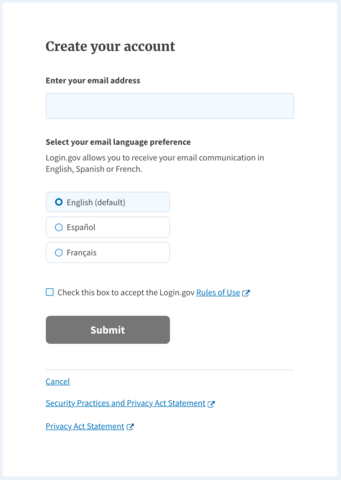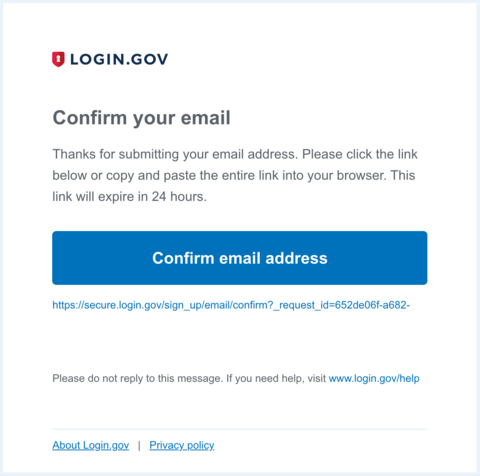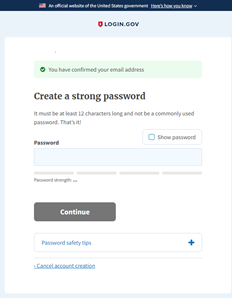Creating a Login.gov Account
To access your iEdison account, you must first create an account with Login.gov.
Login.gov is the universal government account for the public—a shared service and trusted by government agencies. With a Login.gov account, you can access applications from participating government partners. If you already have a Login.gov account, you can use that existing account to access iEdison (assuming your login.gov account and your iEdison both use the same email address). If you do not have a Login.gov account, the following steps will guide you through the creation process:
1. Submit your email
Go to https://secure.login.gov/sign_up/enter_email.

Enter your email address, select your language preference, and check the box to confirm the Login.gov Rules of Use. We recommend using an individual email address that is exclusively and permanently yours. Once your account is created, you can include an additional email address, such as an alternative work email or personal address, to gain access to your account.
Click the “Submit” button.
2. Confirm your account
Check your email for a confirmation request from Login.gov.
Click the “Confirm your email address” button in the message. This will take you back to the Login.gov website.

3. Create your Login.gov password

Passwords must be at least 12 characters. There are no other restrictions. You may use spaces.
Your Login.gov password should be different from passwords you use for other accounts, such as your bank account or email.
4. Select a two-factor authentication method
Login.gov requires you to set up a secondary authentication method to keep your account secure as an added layer of protection. This is referred to as two-factor authentication (2FA).
While only one secondary authentication method is required, we encourage you to add two methods to your account. That way you will have a backup if you lose access to your primary authentication method.
You can choose from several authentication options:
More secure:
- Authentication application
- Security key
- PIV or CAC card for federal government employees or military (NOTE: iEdison requires this authentication method if you are an agency user)
Less secure:
- Text message
- Phone call
- Backup codes
NOTE: For more information on these authentication methods, click here.
Once authenticated, your Login.gov account is active.
After logging in to Login.gov, you will be taken to your Login.gov account page or the government webpage you are trying to access. You can add additional authentication methods, email addresses, or update your information on the Login.gov account page.
Authentication options
In addition to your password, Login.gov requires that you set up at least one secondary authentication method to keep your account secure. This is two-factor authentication (2FA). We use 2FA as an added layer of protection to secure your information. Although you can choose from several authentication options, some authentication methods such as security keys, PIV/CAC cards, and authentication applications are more secure against phishing and theft. We encourage you to add two methods for authentication to your account. If you lose access to your primary authentication method (i.e., losing your phone), you’ll have a second option to gain access to your account. Login.gov is unable to grant you access to your account if you get locked out and/or lose your authentication method.
|
Authentication options |
Definition |
|
Authentication application |
Authentication applications are downloaded to your device and generate secure, six-digit codes you use to sign in to your accounts. While authentication applications are not protected if your device is lost or stolen, this method offers more security than phone calls or text messaging against phishing, hacking, or interception. If you choose this secure option, follow these steps to download and install one of the supported applications and configure it to work with Login.gov.
You will now be able to use the one-time passcodes generated by the application each time you sign in to Login.gov. |
|
Security key |
A security key is typically an external physical device, like a USB stick that plugs into your computer. The key is linked to your accounts and will only grant access to those accounts once the key is inserted and activated. Since a security key does not rely on your cell phone, it has the highest level of protection against phishing and built-in protections against hacking if it is lost or stolen. Login.gov requires security keys that meet the FIDO (Fast Identity Online) standards. You can add as many security keys as you want to secure your account. To use this secure option for Login.gov authentication, insert the key into a USB port and assign the key a name to identify it with your Login.gov account. You may need to press a button on the key to begin the setup process. The system will then prompt you to activate your key. |
|
PIV or CAC for federal government employees and military |
Physical PIV (personal identity verification) cards or CACs (common access cards) are secure options for federal government employees and military personnel. These cards, with encrypted chip technology, are resistant to phishing and difficult to hack if stolen. |
|
Text message / Phone call |
Text messages/SMS or phone calls are convenient but are extremely vulnerable to theft, hackers, and other attacks. If you choose to use this less secure option, enter a phone number to which you can receive phone calls or text messages. If you only have a landline, you must receive your security code by phone call. Login.gov cannot send security codes to extensions or voicemails. The system will send a unique security code to that phone number each time you sign in to your Login.gov account. Each security code expires after ten minutes and can only be used once. If you don’t enter the security code within ten minutes, request a new code. After you receive the code, type it into the “one-time security code” field. Each time you sign in to Login.gov, you’ll have the option of getting a new security code by phone call or by text. You will receive a new security code each time you sign in to your Login.gov account. |
|
Backup codes (less secure) |
Backup codes are an accessible option for users who do not have access to a phone. However, backup codes are the least secure option for two-factor authentication. Backup codes must be printed or written down which makes them more vulnerable to theft and phishing. If you select this less secure option, Login.gov will generate a set of ten codes. After you sign in with your username and password, you will be prompted for a code. Each code may be used only once. When the tenth code has been used, you will be prompted to download a new list. Treat your recovery codes with the same level of care as you would your password. |
|
No phone or other authentication method (less secure and not recommended) |
If you do not have access to a phone, authentication application, security key, or any other authentication option, you can set up your account with only backup codes. Warning: Setting up your account with backup codes as your only authentication method is not recommended. If you ever lose your backup codes, you will not be able to sign in to your account. When you create your account, you will reach the “Secure your account” page. This is where you must choose your primary authentication method. If you do not have access to any of the other options, select “Backup codes” and click “Continue.” On the “Add another method” page, select “I don’t have any of the above” and click “Continue.” |

